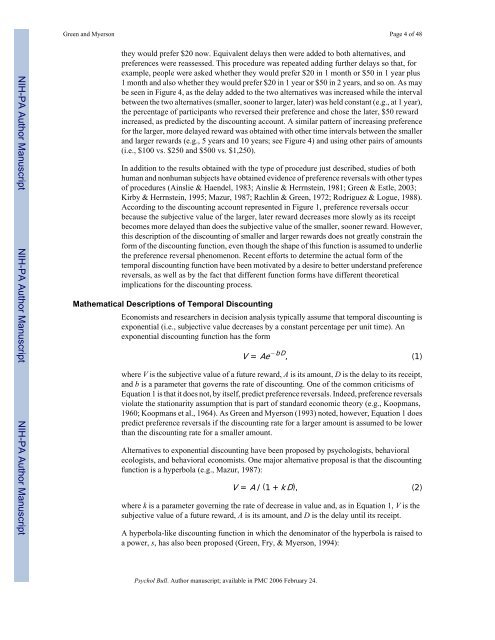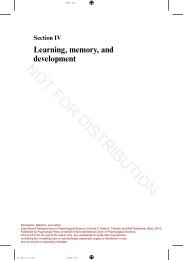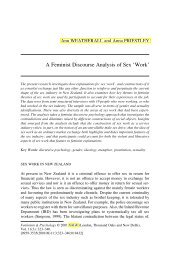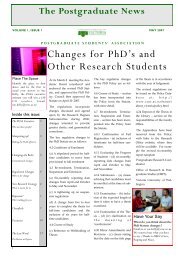green & myerson 2004.. - of /courses
green & myerson 2004.. - of /courses
green & myerson 2004.. - of /courses
You also want an ePaper? Increase the reach of your titles
YUMPU automatically turns print PDFs into web optimized ePapers that Google loves.
Green and Myerson Page 4 <strong>of</strong> 48<br />
NIH-PA Author Manuscript NIH-PA Author Manuscript NIH-PA Author Manuscript<br />
they would prefer $20 now. Equivalent delays then were added to both alternatives, and<br />
preferences were reassessed. This procedure was repeated adding further delays so that, for<br />
example, people were asked whether they would prefer $20 in 1 month or $50 in 1 year plus<br />
1 month and also whether they would prefer $20 in 1 year or $50 in 2 years, and so on. As may<br />
be seen in Figure 4, as the delay added to the two alternatives was increased while the interval<br />
between the two alternatives (smaller, sooner to larger, later) was held constant (e.g., at 1 year),<br />
the percentage <strong>of</strong> participants who reversed their preference and chose the later, $50 reward<br />
increased, as predicted by the discounting account. A similar pattern <strong>of</strong> increasing preference<br />
for the larger, more delayed reward was obtained with other time intervals between the smaller<br />
and larger rewards (e.g., 5 years and 10 years; see Figure 4) and using other pairs <strong>of</strong> amounts<br />
(i.e., $100 vs. $250 and $500 vs. $1,250).<br />
In addition to the results obtained with the type <strong>of</strong> procedure just described, studies <strong>of</strong> both<br />
human and nonhuman subjects have obtained evidence <strong>of</strong> preference reversals with other types<br />
<strong>of</strong> procedures (Ainslie & Haendel, 1983; Ainslie & Herrnstein, 1981; Green & Estle, 2003;<br />
Kirby & Herrnstein, 1995; Mazur, 1987; Rachlin & Green, 1972; Rodriguez & Logue, 1988).<br />
According to the discounting account represented in Figure 1, preference reversals occur<br />
because the subjective value <strong>of</strong> the larger, later reward decreases more slowly as its receipt<br />
becomes more delayed than does the subjective value <strong>of</strong> the smaller, sooner reward. However,<br />
this description <strong>of</strong> the discounting <strong>of</strong> smaller and larger rewards does not greatly constrain the<br />
form <strong>of</strong> the discounting function, even though the shape <strong>of</strong> this function is assumed to underlie<br />
the preference reversal phenomenon. Recent efforts to determine the actual form <strong>of</strong> the<br />
temporal discounting function have been motivated by a desire to better understand preference<br />
reversals, as well as by the fact that different function forms have different theoretical<br />
implications for the discounting process.<br />
Mathematical Descriptions <strong>of</strong> Temporal Discounting<br />
Economists and researchers in decision analysis typically assume that temporal discounting is<br />
exponential (i.e., subjective value decreases by a constant percentage per unit time). An<br />
exponential discounting function has the form<br />
V = Ae −bD , (1)<br />
where V is the subjective value <strong>of</strong> a future reward, A is its amount, D is the delay to its receipt,<br />
and b is a parameter that governs the rate <strong>of</strong> discounting. One <strong>of</strong> the common criticisms <strong>of</strong><br />
Equation 1 is that it does not, by itself, predict preference reversals. Indeed, preference reversals<br />
violate the stationarity assumption that is part <strong>of</strong> standard economic theory (e.g., Koopmans,<br />
1960; Koopmans et al., 1964). As Green and Myerson (1993) noted, however, Equation 1 does<br />
predict preference reversals if the discounting rate for a larger amount is assumed to be lower<br />
than the discounting rate for a smaller amount.<br />
Alternatives to exponential discounting have been proposed by psychologists, behavioral<br />
ecologists, and behavioral economists. One major alternative proposal is that the discounting<br />
function is a hyperbola (e.g., Mazur, 1987):<br />
V = A / (1 + k D), (2)<br />
where k is a parameter governing the rate <strong>of</strong> decrease in value and, as in Equation 1, V is the<br />
subjective value <strong>of</strong> a future reward, A is its amount, and D is the delay until its receipt.<br />
A hyperbola-like discounting function in which the denominator <strong>of</strong> the hyperbola is raised to<br />
a power, s, has also been proposed (Green, Fry, & Myerson, 1994):<br />
Psychol Bull. Author manuscript; available in PMC 2006 February 24.






